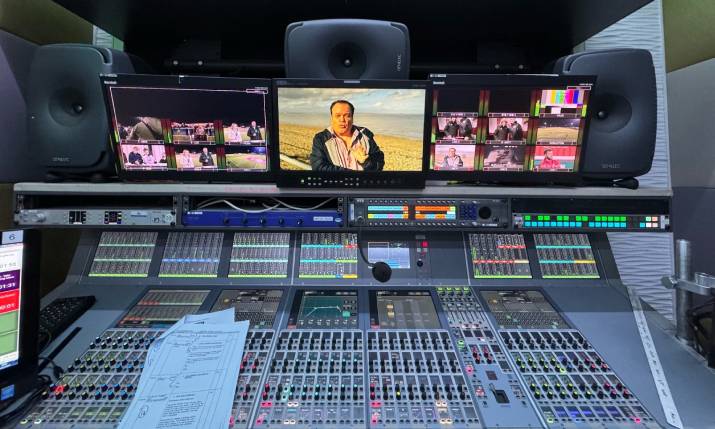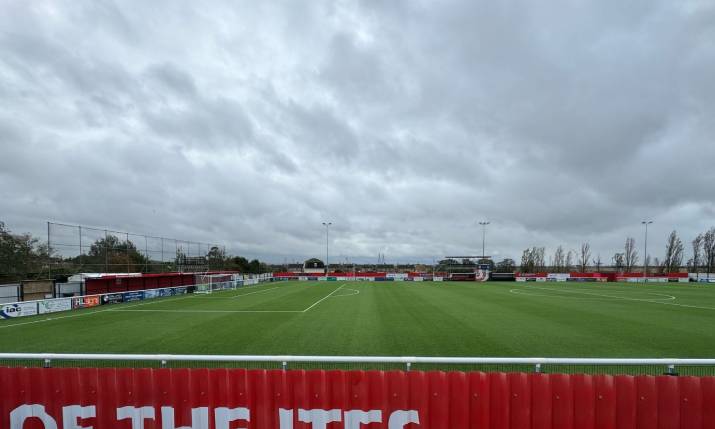Power to the people: How the sound of the FA Cup tells stories

Inside the OB sound booth with Shaun Williamson – best known as Barry from British soap opera Eastenders – at Sheppey FC
We all love an underdog, and the FA Cup is all about the underdog. Established in 1871, the FA Cup is not only the oldest football knockout competition in the world, but is also open to every single club in the English football league system.
It is very special, and not just because of the fixtures but because of the stories. Unlike any other knockout competition, the FA Cup is about giving everyone an equal shot. It is about class as much as it is about football, giving scrappy village teams an opportunity to compete against much bigger clubs, and shining a spotlight on the communities who work tirelessly behind the scenes to make everything happen.
This year more than 700 teams entered, and in November, sound supervisor Max Dighton helped kick off this year’s run for ITV when eighth-tier Southern Counties East Football League side Sheppey United took on League Division 2 side Walsall in round one.
In front of a 1,530-capacity crowd at its Holm Park ground on the Isle of Sheppey, the game was so hotly anticipated that the club had to commandeer the Oasis school car park next door for extra parking and had so many people through the turnstiles that it had to ban the sale of chips from the burger bar to reduce waiting times.
Access all areas
Despite having mixed hundreds of football matches, from Sheppey United right up to the World Cup in Qatar, Dighton is sold on the romance and the storytelling of the FA Cup and the way he approaches the audio presentation reflects that.
“It’s not just about the game in those early rounds,” he says. “It’s more about telling the stories of the people behind the game. The fans are so excited that you’re there; the team are so excited, the club chairman is there to greet you in the OB truck. I’ve been to FA Cup grounds where the club brings us bacon butties in the morning. You feel like they’re letting you into their family.”
“There is no infrastructure at a club like that, and so our approach to audio is completely dependent on the venue. It’s similar to how I used to approach front of house gigs on tour where you have to shape the sound to fit the environment”
Crucially, Dighton believes that from an audio perspective, this intimate relationship provides an opportunity to tell a better story. Unlike televised coverage of the higher leagues, it allows a far greater focus on the club itself.
“Technically we’ve got far more access,” he says. “In these early rounds we typically have access to the club staff who we can bring into the presentation, but at the Isle of Sheppey we were also able to mic up the manager and bring his feed into the commentary during the match. At this stage in the competition the commentary team is able to ask how they think it’s going and have a brutally honest conversation as part of the ongoing commentary.
“The level of access in these early rounds is brilliant and that’s why I like it. There’s very little cynicism; everyone is really passionate about their job and it’s refreshing to have those personal viewpoints because they provide the viewer with an entirely different perspective.”

Right next to the pitch: View from the OB sound booth at Sheppey FC
Infrastructure constraints
Having spent seven years working in live sound at the Tunbridge Wells Forum, Dighton has worked in broadcast sound since 2011. In 2015 he joined Sky, where he spent the next three and a half years mixing live football every single week, including one of the very first live to air Dolby Atmos mixes for the Premiership. When it comes to football he absolutely knows what he’s doing, but his approach to capturing the drama of the FA Cup owes as much to his days in live sound as it does to the Premiership.
“A few days after the Isle of Sheppey game I was covering Arsenal at the Emirates stadium,” says Dighton. “The Emirates has a huge patch room that’s got video ready to go, with multi and fibre connections already patched so you can quickly get it pitch side or in the studio. None of that exists at the Isle of Sheppey.
“There is no infrastructure at a club like that, and so our approach to audio is completely dependent on the venue. It’s similar to how I used to approach front of house gigs on tour where you have to shape the sound to fit the environment.
“For starters, there is a lot more rigging to be done. The NEP truck was right up on pitchside; as you opened the door to sound, the pitch was right there! It takes two days to physically run all the multi and the fibre cables in, from all around the ground, over toilets and through burger vans.
“Meanwhile, the commentary position had to be built on a temporary tower, which is not only next close to the pitch but to the crowd as well, so you have to be aware of the spill of the crowd into the commentary mics.
“At smaller grounds, you can hear individual voices, whereas when you’re at somewhere like Arsenal, the crowd noise is so much like that classic white noise sound that it almost sounds like a fake effect. But in a smaller ground you can literally hear everyone talking and shouting.”
Tailormade mic set up
For this reason, Dighton’s microphone approach has to be designed around the venue. At a top flight game there are 12 to 13 mics located around the pitch to enable sound supervisors to follow the ball, but at Sheppey it just was not possible, but nor was it necessary.
“At the Isle of Sheppey, we went with eight mics because otherwise you are just getting crowd noise,” says Dighton. “We used a pair of Sennheiser 416s practically hanging over the pitch to create a stereo crowd image, and at these smaller venues these crowd effect microphones mics can actually capture better kicks.
“We still had mics located at the goal, each corner and far centre, and a more directional Sennheiser 816 on camera three which is located on the centre line. Camera three is kind of your saviour because it pans to follow the ball, and the 816 is a fantastic mic to use because it’s almost like having a parabolic microphone following the ball.
“That’s really all you need. You’re not gaining anything by having a dozen microphones in a stadium of that size. You could literally use camera three and a couple of goal mics.”
Tight squeeze
With advertising hoardings located very close to the back of the goal Dighton could not fit a 416 in the gap, so the sound team placed them on the side of the goals, facing diagonally across. The wooden hoardings – no longer a feature at top-flight stadiums – were also used by Dighton to play a part in the story and add another layer of immersion to the coverage.
He explains: “In a bigger stadiums, if someone in the crowd is banging a big bass drum, I’m furious. It ruins the mix because it’s hitting the compressors and it’s overriding everything that you’ve got set up to capture the ball kicks.
“At Sheppey I’m the opposite; the hoardings are real wooden boards, and you can hear the kids banging on the sides of them all night, and it’s great, it’s real. I love that, because my if my job is to encourage people to buy into the passion of that game, replicating those sounds helps viewers do exactly that.”
Eastenders of Sheppey
As a final indication of how much these games differ from the Premiership, the introduction on the Isle of Sheppey was delivered by actor Sean Williamson, best known as Barry from British soap opera Eastenders.
“We pre-recorded him doing an introduction to the area – a three minute piece of him talking about its wonderful beach and great little café – but he couldn’t be there on the night because he was performing at the Forum in Tunbridge Wells where I learned my craft, which I thought was absolutely hilarious.
“But it encapsulates the romance of the FA Cup. At a game like the Arsenal v Tottenham match later in the week the interview might be with a player in a sterile hotel lobby talking about how much they like football. It’s just not as fun. So yeah, for me the early rounds are all about the fun and the excitement of the people who are there, and we adapt the sound design to best convey all that.”
The match saw the home team go ahead after 21 minutes, but the game ended in a 4-1 defeat as Walsall move on in the competition. But thanks to Dighton, we all bought into the glorious possibility of it all for 90 minutes.

